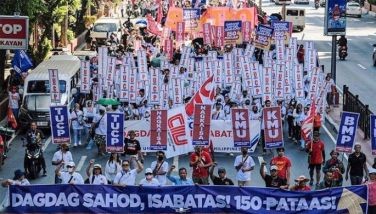The MIF and its 10x multiplier effect
While questions remain on who will manage the Maharlika Investment Fund (MIF) and how it will be governed, there is a lot of potential and the MIF can really jumpstart the infrastructure projects the country badly needs. We believe that the government, through the MIF, will be able to spread its limited resources over various projects and create a 10x multiplier effect via its equity investments. BDO has had significant experience structuring, advising, and funding PPP and other infrastructure projects. We wanted to share our thoughts on how we could maximize the MIF.
In achieving the target infrastructure spend of at least five percent of GDP, one of the ways by which the government intends to support it is through the establishment of the country’s first sovereign wealth fund. Last July, the act creating the MIF was signed into law. It will have an initial capitalization of P125 billion, which will be funded by contributions from government banks and the national government.
Currently, the government has 194 projects in the pipeline with a total indicative project cost of P8.3 trillion. The projects will be financed mainly by Official Development Assistance (ODA) from other countries, the national budget, and through Public-Private Partnerships (PPP). The projects include tollways, airports, railways, and bus transit systems (BRT), among others, which will provide the physical backbone connecting the country’s economic institutions and facilitating trade movement.
ODA projects and those funded by the national government mean that the government owns the projects and will not need external equity funding. So, of the total 194, there are 37 projects costing around P2.5 trillion that will be funded via PPP. This is one of the key opportunities where the MIF can invest in.
A typical project financing structure is 70 percent debt and 30 percent equity. Majority, or around 67percent of the equity is usually owned by the local sponsor, and they may partner with a foreign sponsor who has expertise running and operating such projects. They may also take in financial partners and this is where it makes sense for the MIF to invest up to 33 percent of the equity, which is effectively 10 percent of the total project. The MIF shouldn’t invest more than one-third so that there is also “skin in the game” from other investors and, thus, provide a “sanity check” on the viability of projects. Having MIF as an investor for such projects should be welcomed by sponsors to promote better government-to-government relationships involving concession agreements.
So, how can we maximize the MIF that generates a 10x multiplier effect (one third of the 30 percent equity or 10 percent of the project cost)? The equity requirement of the identified P2.5 trillion PPP projects total around P750 billion, of which the MIF can invest at least P75 billion of its initial P125 billion funding. It will have P50 billion to invest in other projects that have not yet been identified. Further capital infusion is expected to be made in the future by the government and its instrumentalities. It is open as well to take investments from multilateral and offshore institutions, and the private sector.
Once the MIF is able to generate returns for its shareholders, it can become a self-financing mechanism to attract further capital in the fund, which it can, in turn, use again to fund other infrastructure projects whether solicited or unsolicited, and other investment opportunities. The MIF can also borrow funds to allow it to even invest more. We have seen these kinds of structures where the MIF borrows from banks to allow it to find more projects and hopefully generate a higher return.
Aside from the 10x multiplier effect, other expected benefits from MIF’s investment in PPP projects include (i) earning better risk-adjusted returns for the fund, (ii) improved governance of projects resulting from private sector participation as they would be more prudent in their investment decisions given the higher equity commitment, (iii) diversified funding sources for the government (outside ODA and using government coffers), and (iv) enhanced credibility on investments benefiting from the lead sponsors’ assessment of the project’s feasibility and bankability.
While there are challenges, the continuous and consistent work by all economic participants over a long period of time is needed to close the infrastructure gap. The MIF, which is one of the vehicles that the government will employ to support infrastructure spending and enable economic development, is a welcome addition to its arsenal.
About the author: Eduardo V. Francisco is the president of BDO Capital & Investment Corporation (BDO Capital) and vice chair of SharePHIL. BDO Capital is the leading investment bank in the country. It has consistently been named as Best Project Finance House by various capital market stakeholders, and has supported the financing of various PPP, infrastructure, power and other key projects in the country for over 20 years.
The Shareholders’ Association of the Philippines (SharePHIL) is a non-stock, non-profit organization whose mission is to protect and promote the interest of minority shareholders and retail investors, as well as enhance Philippine capital markets through financial literacy and investor education programs, and by promoting investor relations best practices.
Our goal is to to become the most preferred non-profit organization as a source of investor knowledge and a strong advocate of investor rights.
We envision a nation where every Filipino enjoys quality life and financial security supported by a fair, accessible, and sustainable capital market system.
To learn more about SharePHIL, visit https://bit.ly/m/sharephil
- Latest
- Trending






























